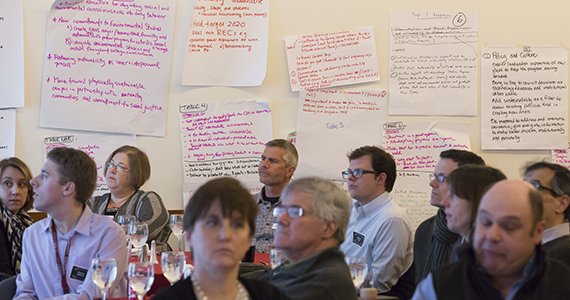Sustainability Charrette Spurs Discussion, Debate

As attention increases around the world, and at Swarthmore, for divestment from fossil fuels, last month’s Sustainability Charrette generated proposals in six critical areas for the College community’s consideration and action. Those proposals, detailed in the report [pdf] released this week from the event, include improving the College’s energy efficiency, installing a renewable energy system on campus, evaluating how the College’s endowment is invested, and becoming a zero-waste campus.
The charrette, sponsored by the Board of Managers, was held in February and attended by more than 100 students, faculty, staff, alumni, Borough officials, and community partners. It followed a call to the community from Interim President Constance Hungerford last fall for ways the College could address climate change. The community responded by suggesting more than 160 ideas and the charrette provided a forum in which these and other ideas could be discussed and evaluated.
The critical issue of how to address climate change on campus is not new. Two years ago in a letter to the community, Board Chair Gil Kemp ’72 described the Board’s support of the College’s efforts and investment in the issue. He cited the adoption of the College’s Climate Action Plan [pdf], which pledges carbon neutrality by 2035. (Accelerating this goal to 2020 is another idea under careful consideration.) “The College,” he added, “has expanded faculty lines and resources for environmental studies in order to prepare students in their lives and in their careers to develop real and permanent solutions to climate change-solutions rooted in energy efficiencies and the urgent need to develop alternative energy sources.”
Some of the charette proposals, such as improving the College’s energy efficiency, reflect priorities already identified and supported by the Board. In December, for example, the Board committed $12 million toward making the planned Biology, Engineering, and Psychology building a model for environmentally intelligent construction practices. Others, such as those involving the endowment, continue to generate debate. Last week, a group of students and alumni began a sit-in, still underway, outside the College’s Finance and Investment Office to urge the College’s Board to “begin a process towards fossil fuel divestment.”
Two years ago, according to Investment Committee Chair Chris Niemczewski ’74, Board members had several concerns that led them to reach consensus and decide against divestment. “Many of us," he says, "including me, believed there would be a cost to the endowment if we did." This is of particular concern, he says, given that the College relies on endowment revenue for 50 percent of its annual budget, including the increase in financial aid planned for next year.
“Second,” he adds, “there were some questions about the efficacy of divestment as a strategy. The general sense was that divestment would convince those who are already convinced about the dangers of climate change and fail to impress those who are in the fossil fuel business.” [Learn more from Niemczewski about the College’s endowment and the Board’s decision not to divest in the spring Bulletin].
A third reason that the Board ultimately decided not to divest was its sense of commitment and obligation as stewards of the College’s endowment, which is only possible as a result of generations of Swarthmore alumni contributing to the College and its future. The Investment Committee’s guidelines prohibit use of the endowment to express opinions on social issues. As Kemp stated in 2013, “The Board is not prepared to accept the significant cuts in scholarships, faculty, and curriculum offerings that a significantly lower endowment return would necessitate.” Focusing on the use, rather than the production of carbon resources, he added that it is also important to acknowledge, “that our consumption of energy makes us complicit in the threat to the planet and that it is in our hands to reduce our demand for it.”
Niemczewski says the Investment Committee will address the ideas that arose from the charrette relating to the endowment at its next meeting, and the broader discussion of the committee’s guidelines will be considered by the full Board.
Further, when Hungerford addressed those attending the sit-in late last week, she noted that the Board of Managers’ Quaker-based tradition of consensus decision making would necessitate a broader conversation by the full Board. She also informed them that many of the charrette proposals, including those pertaining to the investment portfolio, were already slated to be considered by the Board at its May meeting.
“We are listening to your voices, and to all of the voices of our students, faculty, staff, and alumni,” she said. “We are considering what we hear thoughtfully. We respect your decision to engage in peaceful protest.
“We can’t be sure that each one of you will be satisfied by our decisions,” she added, “but I promise you we are listening very carefully.”


